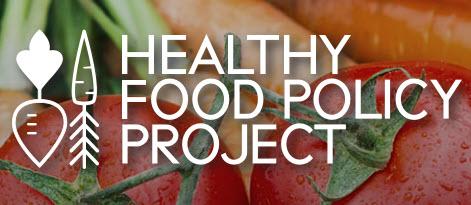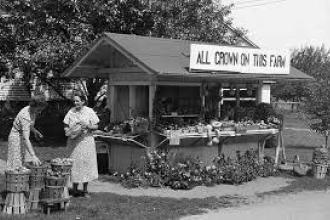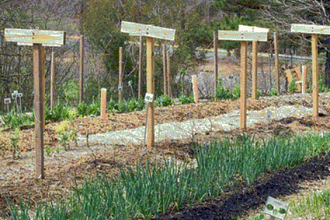
Urban agriculture allows for the development of a variety of environmental, economic, and social benefits to the surrounding communities. Urban farming can reduce transportation costs, help reduce runoff associated with heavy rainfall, and lead to better air quality. On this page, find links to USDA and other federal resources, legal information, funding opportunities, recent publications, and historical materials.
USDA and Urban Farming
The U.S. Department of Agriculture (USDA) has a history of supporting urban agriculture as part of the local and regional food systems. Examples include USDA farmers market programs, rural cooperative grants, child nutrition programs, and USDA research and cooperative extension services. This support expanded with the enactment of the 2018 Farm Bill (Agriculture Improvement Act of 2018, P.L. 115-334) [congress.gov, pdf, 529 pages], which authorized numerous resources for urban agriculture, including:
- an Office of Urban Agriculture and Innovative Production to encourage and promote urban, indoor, and other emerging agricultural practices;
- an Urban Agriculture and Innovative Production Advisory Committee;
- USDA grant authority to support urban agriculture development and innovative production; and
- pilot projects for counties with a high concentration of urban or suburban farms.
USDA established the Federal Advisory Committee for Urban Agriculture and Innovative Production [usda.gov] in 2022.
Find Information
Legal Issues in Urban Agriculture
-
USDA's Efforts to Promote and Support Urban Agriculture [nationalaglawcenter.org]
A report from NALC detailing USDA's emerging Urban Ag programming.
-
Farmers Market Legal Toolkit [CAFS]
Legal resources for building resilient and accessible markets.
-
Managing legal risks to grow your urban farm [extension.umd.edu]
Highlighting common legal concerns that may arise during urban farm operation.
Zoning

Zoning for Urban Agriculture [healthyfoodpolicyproject.org], a guide from the Healthy Food Policy Project by the Center for Agriculture and Food Systems at Vermont Law School (CAFS), summarizes zoning laws that promote and support agriculture in urban areas. The guide can be used to help update local city laws to promote healthy food production and access.
Frequently Asked Questions (FAQs)
What is the definition of urban agriculture?
Currently there is not a statutory or single formal definition of urban agriculture. The definition differs depending upon policy, state, or the community. The definition is often dictated by local policy (especially policy particular to funding/programming) and may not make sense for all communities who are technically participating in urban agriculture. The definitions are often community specific.
Federal references:
Urban agriculture, is "[c]ity and suburban agriculture [that] takes the form of backyard, roof-top and balcony gardening, community gardening in vacant lots and parks, roadside urban fringe agriculture and livestock grazing in open space." [EPA [epa.gov] website (9/23/2022)]
"Urban agriculture includes the cultivation, processing and distribution of agricultural products in urban and suburban areas. Community gardens, rooftop farms, hydroponic, aeroponic, and aquaponic facilities, and vertical production are all examples of urban agriculture. Tribal communities and small towns may also be included." [USDA [usda.gov] website (9/23/2022)]
While urban agriculture is not defined by U.S. law, the 2018 Farm Bill (Agriculture Improvement Act of 2018, P.L. 115-334) [congress.gov, pdf, 529 pages] refers to the urban farming demographic as urban, indoor, and other emerging agricultural production.
Are there different types of urban farms?
Yes. Urban agriculture is loosely defined as the production, distribution, and marketing of food and other products within the geographical limits of a metropolitan area. This includes community and school gardens, backyard and rooftop plots, and non-traditional methods of caring for plants and animals within a constrained area. Some definitions also include farms that supply to urban farmers markets, community supported agriculture, or farms located within metropolitan green belts.
Key Types of Urban Farms
- Institutional Farms and Gardens
Typically linked with an institution (such as hospitals, churches, prisons, schools, public housing) whose primary mission is not large-scale food production, but instead to provide health, educational, and lifestyle opportunities.
- Community Gardens
Usually located on publicly-owned land or land trusts and managed by local resident volunteers. Community gardens mostly grow food, but some also grow flowers. Some community gardens provide space for community gatherings and events.
- Community Farms
Communal growing spaces operated by a nonprofit organization that engages the surrounding community in food production as well as social and educational programming.
- Commercial Farms
Some for-profit farms exist in urban areas, although they tend to be small and often produce niche products. Some small urban commercial farms focus on non-traditional growing techniques like vertical or soilless farming.
Does the USDA offer funding to start an urban farm?
USDA funding programs, including loans, grants, and cooperative agreements, encompass urban agriculture. Access these websites to review programs and other options:
- Urban Agriculture Programs at a Glance. [farmers.gov]
- Urban Growers. [farmers.gov]
- Urban Agriculture and Innovative Production Grants [usda.gov]
- Composting and Food Waste Reduction (CFWR) Cooperative Agreements [usda.gov]
Many states and local governments also offer funding programs. Access each state’s department of agriculture at the National Association of State Departments of Agriculture’s state directory [nasda.org].
Can local government place restrictions on farms due to noise, pollution or odors?
All fifty states have right-to-farm statutes. These laws are meant to protect farmers from nuisance lawsuits filed by an individual who moves to an area where a farming operation exists, or in some cases where a farm has existed substantially unchanged for some time, and who files a lawsuit to stop the farming operation.
However, there are some limitations to the protections provided by right-to-farm statutes. Some states condition nuisance protection on a farm's compliance with state and federal laws and if the operation follows good agricultural practice. These limitations fall into at least one of the following categories.
- Compliance with State and Federal Laws: The farming operation must be compliant with the applicable state and federal laws, otherwise the right-to-farm nuisance suit protection does not apply.
- Following Good Agricultural Practice: Various states’ right-to-farm laws are only applicable to farms that follow good agricultural practices. Some states may legally define “good agricultural practices;” other states have provisions that generally require the farming operation to comply with good agricultural practices as required by industry customs.
- Public Health and Safety: If the farming operation has an adverse effect on public health and safety, the operation may be considered a nuisance.
Are there safety issues involved in urban farming?
Yes. One major safety concern is the risk of contaminants, lead or other heavy metals in the soil. It is important to investigate the history of the land where produce may be grown, especially if the land is near a former industrial site. Soil tests are recommended for all new gardening sites. In areas with soil health issues, using raised beds or planting in imported soil may reduce the chances of contamination.
How does zoning affect urban agriculture?
Zoning is a critical issue in urban agriculture. Zoning dictates what growing is allowed and whether animal farming is permitted. Most cities have strong restrictions on raising animals for production purposes, so most urban farming involves gardening.
The Healthy Food Policy Project has a guide on zoning for urban agriculture [healthyfoodpolicyproject.org] that addresses zoning laws that can support urban farming and access to healthy food.
Featured Resources
Digital Exhibit: Mailboxes, Mom and Pop Stands, and Markets: Local Foods Then and Now

NAL holds historical and current materials documenting the ways that food makes its way from the farm to our tables.
Urban Agriculture Toolkit

The USDA toolkit covers the common operational elements urban farmers must consider when starting or growing their operations. It identifies technical and financial resources available from federal, state, and local partners that support a variety of activities.
Digital Exhibit: Small Agriculture

NAL showcases three USDA initiatives in support of small-scale farming and niche agriculture: the school garden, subsistence homesteads, and victory gardens and farms.
 An official website of the United States government.
An official website of the United States government.